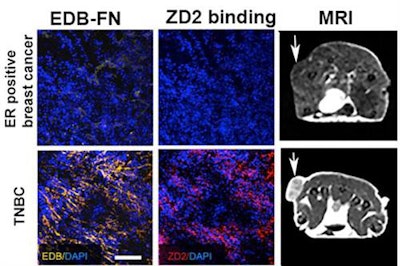
Researchers at Case Western Reserve University are reporting early success with an MRI contrast agent that detects early-stage breast cancer and the disease's degree of aggression. Results were published online September 25 in Nature Communications.
The agent combines commercially available trigadolinium nitride metallofullerene (Gd3N@C80) with a peptide the researchers developed, labeled ZD2. The gadolinium-based contrast agent could be more efficient and safer than traditional agents because it requires 20 times less gadolinium in a dose, according to lead researcher Zheng-Rong Lu, PhD, and colleagues.
Given the reduced amount of gadolinium, the element is more easily flushed from the body and leaves no accumulation in tissues in tests with mouse models, the researchers found. The agent also highlights cancer biomarkers during MRI scans.
The key technology for the targeted contrast agent is the attached peptide, Lu explained in a press release. The lab applies ZD2 to the surface and the peptide specifically targets the cancer protein extra domain-B fibronectin (EDB-FN). EDB-FN is associated with tumor invasion, metastasis, and drug resistance.
 Images show the different expression of the biomarker (EDB-FN) and probe binding (ZD2) in slow-growing estrogen receptor-positive breast cancer (ER-positive, low expression of the biomarker and low binding) and in triple-negative breast cancer (TNBC, high expression and high binding). As a result, the contrast agent produced weak signal enhancement (brightness) in the former and strong signal in the latter (arrow). Images courtesy of Case Western Reserve University.
Images show the different expression of the biomarker (EDB-FN) and probe binding (ZD2) in slow-growing estrogen receptor-positive breast cancer (ER-positive, low expression of the biomarker and low binding) and in triple-negative breast cancer (TNBC, high expression and high binding). As a result, the contrast agent produced weak signal enhancement (brightness) in the former and strong signal in the latter (arrow). Images courtesy of Case Western Reserve University.Lu and colleagues tested Gd3N@C80 on six mouse models, and the agent detected breast cancers in all six cases. However, the signal created by the accumulation of contrast molecules on three aggressive triple-negative breast cancers was significantly brighter. Conversely, because slow-moving estrogen receptor-positive breast cancers produce less EDB-FN, fewer molecules attached, resulting in a muted signal.
The researchers plan to look at ways to reduce the cost of producing the agent to make it more attractive for clinical use.


.fFmgij6Hin.png?auto=compress%2Cformat&fit=crop&h=100&q=70&w=100)





.fFmgij6Hin.png?auto=compress%2Cformat&fit=crop&h=167&q=70&w=250)











